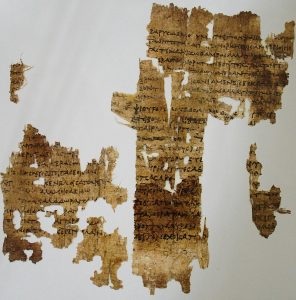
Dr Laura Swift, The Open University.
Recently funded by the British Academy, the aim of The Art of Fragments project is to explore creative responses to fragments and fragmentation, by bringing together academics and creative practitioners from a range of fields.
The Art of Fragments is a project about lost and fragmented texts. Many texts from the ancient world were damaged or lost, and survive only in small fragments. These are the works that didn’t survive the process of history that led to the ‘classics’ we know today being preserved intact.
Some of these works have been partly rediscovered, through papyrus fragments from an ancient rubbish dump, and through the random luck that made other authors decide to quote lines from them.

The papyrus pictured (left) preserves the Tithonus poem (fragment 58); the potsherd (right) preserves fragment 2. By Masur – Own work, CC BY-SA 2.5, https://commons.wikimedia.org/w/index.php?curid=2648372
The fragments may be a whole speech or self-contained passage, but they can also be as small as a single word, or as random as having only the right hand edge of a piece of text.
Traditionally, Classical scholars have tried to make sense of these fragments by painstakingly analysing and reconstructing them, filling in gaps or trying to work out where they come from. But things that only survive in pieces are also intrinsically compelling, and take on a beauty of their own.
